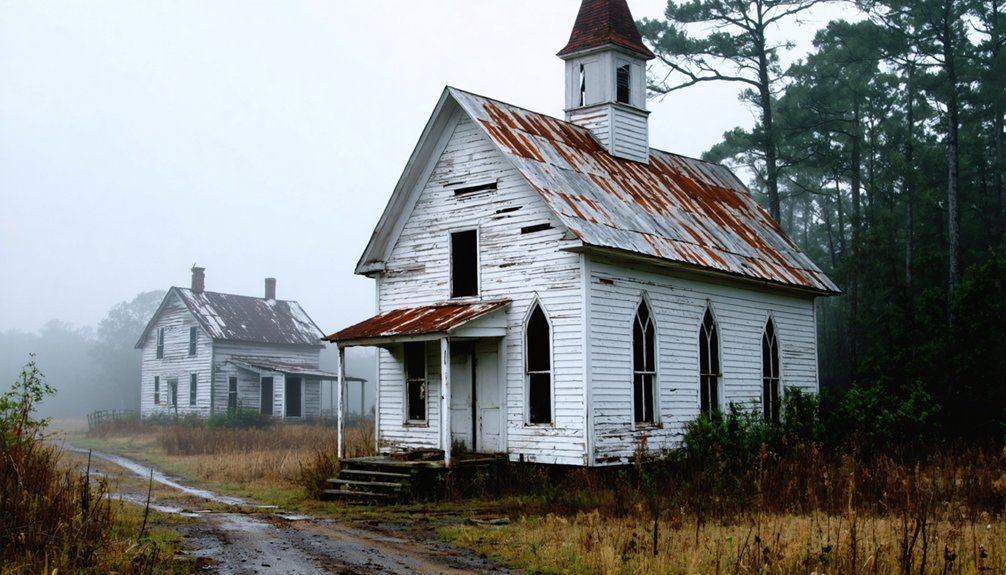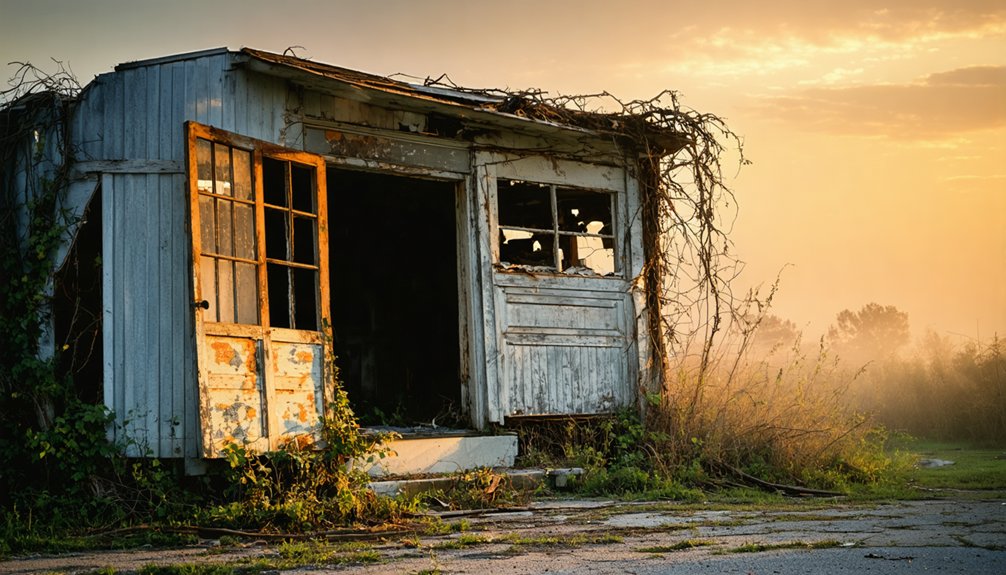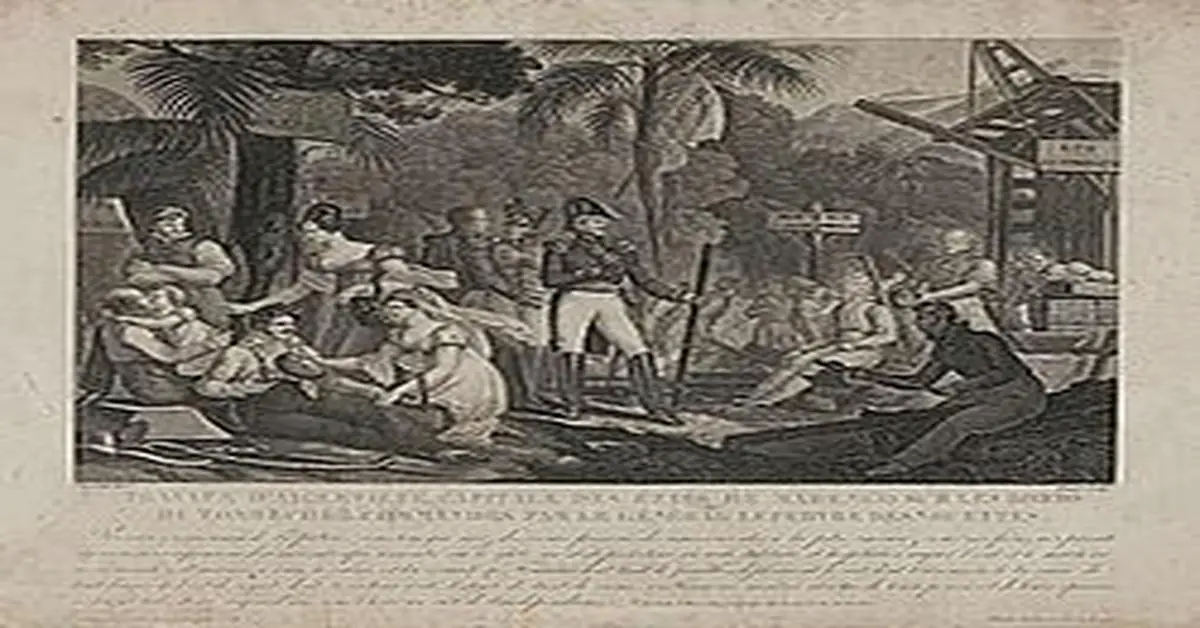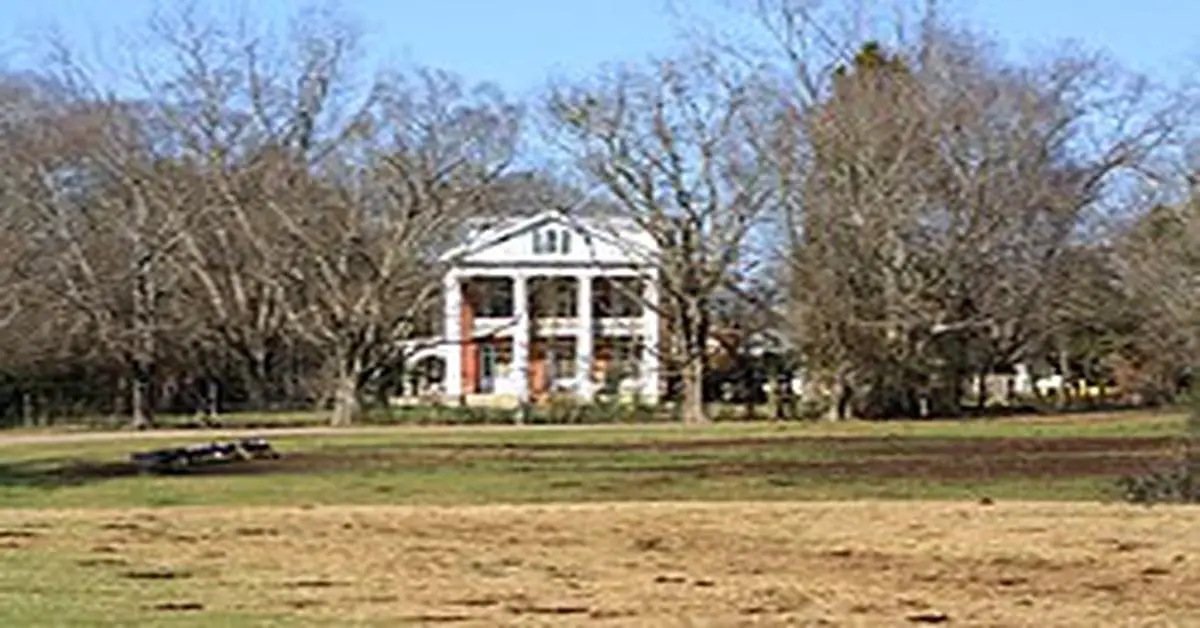You’ll find Failetown, a haunting ghost town in Clarke County, Alabama, established by Lewis Faile and his family in the 1850s. The settlement grew to include a post office and several homes, with the Faile, Mott, and Agee families forming its core community. Today, only scattered remnants remain, including the historic Faile Cemetery and a restored 1979 FEMA trailer. The site also witnessed the notable Bashi Skirmish of 1813, a tale that echoes through Alabama’s frontier history.
Key Takeaways
- Failetown was established in the 1850s by Lewis Faile in Clarke County, Alabama, and grew to include a post office and several homes.
- The abandoned town now consists mainly of deteriorating family homes, hunting camps, and the Faile Cemetery as its only permanent marker.
- A 1979 FEMA trailer has been restored for seasonal use, while most other structures have been reclaimed by nature.
- The site holds historical significance as the location of the 1813 Bashi Skirmish during the Creek War.
- Local organizations and descendants actively participate in preservation efforts to maintain the ghost town’s historical legacy.
The Origins of a Lost Alabama Settlement
When Lewis Faile and his children journeyed from South Carolina to settle in Clarke County, Alabama in the 1850s, they couldn’t have known their small community would one day become a ghost town.
You’ll find that their settlement patterns reflected the rural migration common to mid-19th century Alabama, as families sought new opportunities in the dense pine forests along the Tombigbee River.
The area they chose already held historical significance as the site of the 1813 Bashi Skirmish during the Creek War. Colonel William McGrew and four other militiamen lost their lives in this tragic ambush.
Though isolated by miles of dirt roads, Failetown grew to include a post office and several family homes. Today, the location remains secluded with nearest neighbors located over a mile away.
The Failes were joined by other families like the Motts and Agees, forming a close-knit community that, while never formally incorporated, established itself as a recognized settlement.
The Founding Faile Family Legacy
Although Lewis Faile’s decision to settle in Clarke County would shape generations to come, his family’s profound impact on the region extends far beyond the town’s name.
The Faile family’s influence reaches deeper than mere geography, weaving an enduring legacy throughout Clarke County’s historical fabric.
When you trace the Faile family’s influence through time, you’ll find their footprints deeply embedded in the cultural heritage of the area, from the well-preserved Faile Cemetery to the vast tracts of land they’ve maintained since the 1850s.
Lewis’s children – Richmond, Terrell, and Morgan – established strong roots that would flourish through descendants like John Amos Faile and Eddie Lee Faile.
Even today, you can witness their legacy through Nina Faile’s continued connection to the ancestral property. Their rich history includes the remarkable story of Thomas Faile’s settlement from South Carolina to Alabama in the early 1800s. Modern family researchers can explore their ancestry through genealogical databases on FamilySearch.org.
While Failetown may have transformed into a ghost town, the family’s commitment to preserving their heritage remains unwavering, as evidenced by their careful stewardship of historical sites and cultural landmarks.
The Bashi Skirmish of 1813
During the early days of the Creek War in October 1813, a deadly ambush near Bashi Creek would forever mark the landscape of present-day Failetown, Alabama.
You’ll find that this pivotal skirmish showcased the masterful Bashi tactics employed by 30-50 Creek warriors who utilized their intimate knowledge of the terrain to devastating effect.
As Colonel William McGrew led his 25 militia horsemen from St. Stephens toward Fort Easley, the Creek resistance released their carefully planned attack.
Using a turkey tail raised above a log as their signal, they struck with lethal precision. The engagement claimed five American lives, including McGrew himself, and left David Griffin’s body never to be found. The skirmish took place near Fort Easley’s location along the Tombigbee River.
Like the attacks that sparked outrage at Fort Mims, this battle demonstrated the Creeks’ effective guerrilla warfare tactics against American forces.
Today, a historical marker along Woods Bluff Road stands as a memorial to this fierce battle for territorial control.
Life and Death in Early Failetown
The haunting legacy of the Bashi Skirmish gave way to new life as Lewis Faile and his children established Failetown in the 1850s. Life in this rural settlement tested the resilience of early settlers through numerous health challenges and harsh conditions. Like many communities across Alabama, the settlers relied on subsistence farming to survive. Neighboring Choctaw Indians, who had won territorial rights through historic ball games, maintained distinct boundaries with the settlement.
The community dynamics centered around family bonds, religious gatherings, and agricultural cooperation, creating a tight-knit society despite the hardships.
- You’d find yellow fever epidemics devastating the population, reflecting the era’s limited medical knowledge.
- Your chances of survival improved through strong family connections, as evidenced by intermarriage between the Faile, Mott, and Agee families.
- You’d work primarily as a farmer, growing staple crops and raising livestock.
- Your social life would revolve around Methodist church gatherings, which fostered community identity and resilience.
Notable Structures and Remnants
Unlike many historic ghost towns in Alabama marked by industrial ruins, Failetown’s structural legacy primarily consists of scattered domestic remnants and seasonal dwellings.
Similar to Fort Gaines, the area now serves as a historical point of interest for visitors exploring Alabama’s past.
You’ll find a 1979 FEMA trailer, restored for seasonal usage, standing as one of the most notable architectural features of the site.
Along the Tombigbee River, where docks and mills once operated, nature has reclaimed most structural evidence of human activity.
The site’s few remaining buildings include deteriorating family homes and makeshift hunting camps, with dirt roads stretching over three miles providing limited access.
While nearby ghost towns boast remnants of railroads, mines, and industrial complexes, Failetown’s structures reflect its rural character, with pine forests steadily encroaching on what little remains of this once-inhabited community.
The only permanent marker of the town’s existence is the Faile Cemetery, which serves as the final testament to the community’s history.
The Historic Faile Cemetery
Situated at the historic crossroads of Woodsbluff Road and Pearl Drive, Faile Cemetery stands as the last tangible remnant of Failetown’s pioneer heritage.
You’ll find this sacred ground at coordinates 31.9283°N, 88.0161°W, where burial practices of the 19th century tell stories of the town’s founding families.
Through genealogical research, you can trace the legacy of:
Let generations of pioneers and settlers speak through careful study of family lines and ancestral connections.
- Multiple generations of the Faile family, including four Lewis Failes
- The Mott and Agee families who helped establish the settlement
- Pioneers who migrated from South Carolina in the 1850s
- Veterans and civilians connected to the 1813 Bashi Skirmish during the Creek War
The cemetery’s weathered stones and markers, some bearing historical inaccuracies like the misspelled “Fails,” serve as silent witnesses to Alabama’s early settlement period.
Preserving a Ghost Town’s Memory

Despite its abandoned status, Failetown’s legacy lives on through dedicated preservation efforts that combine community engagement, historical documentation, and sustainable tourism practices.
You’ll find community involvement at the heart of preservation techniques, with descendants, local organizations, and regional preservationists working together to protect this historic site.
The town’s preservation follows the “arrested decay” method, which stabilizes structures while maintaining their authentic, weathered appearance.
You can support these efforts by participating in heritage tours, educational workshops, and seasonal events that bring Failetown’s story to life.
Through partnerships with preservation agencies and tourism networks, you’re helping secure resources for ongoing conservation while ensuring future generations can experience this unique piece of Alabama’s history.
Frequently Asked Questions
What Was the Population of Failetown at Its Peak?
You’ll find Failetown’s demographics and historical significance suggest a peak population under 200 residents, though exact numbers weren’t documented in any census records during its 19th-century existence.
Are There Any Ghost Stories or Supernatural Legends Associated With Failetown?
While haunting tales surround the Creek War battlefield and Faile Cemetery, you won’t find well-documented local folklore. Most supernatural associations stem from the town’s abandonment and violent historical past.
How Accessible Is Failetown to Modern-Day Visitors and Tourists?
While you won’t find organized ghost tours, you’ll face significant accessibility challenges visiting Failetown today. You’ll need to navigate unmarked dirt roads, with no facilities or signage to guide your exploration.
What Caused the Eventual Decline and Abandonment of Failetown?
You’ll find the town’s demise stemmed from family dispersal, economic downturn from poor transportation access, lack of commercial development, and the absence of permanent residents maintaining essential community infrastructure.
Did Failetown Have Any Schools, Churches, or General Stores?
With just a small cemetery of Faile, Mott, and Agee families remaining, you won’t find evidence of formal school history or church significance – only a post office among decaying structures survives.
References
- https://digitalalabama.com/alabama-ghost-towns/failetown-alabama/14016/
- https://kids.kiddle.co/Failetown
- https://digitalalabama.com/article/alabama-ghost-towns/page/3
- https://en.wikipedia.org/wiki/List_of_ghost_towns_in_Alabama
- https://www.mariahkarson.com/work/failetown/
- https://pastmaps.com/explore/us/alabama/clarke-county/failetown/hiking-exploration
- https://www.youtube.com/watch?v=hTe8F-_3-hY
- http://wikimapia.org/11077/Failetown-Alabama
- https://www.onlyinyourstate.com/experiences/alabama/abandoned-town-far-away-from-al
- http://faile.org


